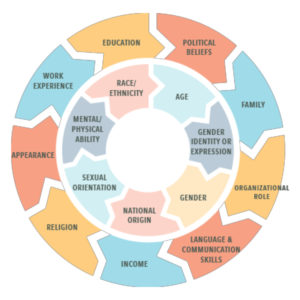Diversity isn’t solely about race. It’s about people who share different values and beliefs than your own. Leadership doesn’t just mean taking on a role within an organization. It also means being a leader in the classroom, and within our evaluation and therapy sessions.
PONDER THIS: WHAT DOES LEADERSHIP MEAN TO YOU?
We need to make sure our diverse voices are heard. We need to set ourselves up for success in leadership roles. So, how do we do that?
Challenges for Minority Students Gaining and Maintaining Leadership Roles
Research shows that very few minority students participate in high-profile leadership roles.
PONDER THIS: WHY DO YOU THINK THERE’S A LOWER RATE OF MINORITY STUDENTS PARTICIPATING IN HIGH-PROFILE LEADERSHIP POSITIONS? HOW CAN WE BREAK THIS BARRIER?
Based off of challenges professionals come across in the workplace, students may also run into similar issues:
- Subtle disregard by others for an assigned task
- Absence of urgency for task completion
- Lack of colleagues coming to meetings
- Feeling of having to prove oneself
- Struggle to delegate authority and responsibility
- Not being shown the same level of respect as others
Strengthening Our Organizations … and the Professions
Minority students’ perspectives add value to the conversation and are very important assets to any organization. When you combine these collective perspectives, only the best end results will be achieved regarding therapy approaches, interpretation of evaluations, and implementation of a new strategic goals.

Strategies for Overcoming Barriers
We’ve all learned about interdisciplinary practice and why collaboration with other professionals is important. Diverse leadership is needed in these situations as well. So, how do we overcome those barriers and challenges we might come across? Check out these strategies:
- Find a mentor who challenges you and evolves your way of thinking. They’ll be able to help you navigate sticky situations too.
- Know yourself. Identify what makes you unique and your strengths—create goals to improve upon them.
- Find resources and information on why leadership is important and how you can begin to gain those skills.
- Know your goals and why you want to achieve them.
- Develop a plan on how you’ll approach your goals—include a timeline.
- Have patience and persistence. Be flexible because not all change can be instantaneous.
- Be authentic and honest—people gravitate towards authenticity.
- Live your truth.
Build a Leadership Portfolio
Additionally, set yourself up for success by building a leadership portfolio—a working document to establish self-directed goals through continuous self-reflection. It can be utilized in any situation where you need to demonstrate your leadership abilities—a job, internship, residency program, or leadership opportunity.
PONDER THIS: WHAT HAVE BEEN YOUR PERSONAL SET-BACKS? YOUR BREAKTHROUGHS? REFLECT ON HOW YOU FELT AND WHAT YOU LEARNED FROM THOSE EXPERIENCES.
Your leadership portfolio captures who you are as a leader today, the type of leader you wish to become, and the steps you’re going to take to get there. A leadership portfolio should include:
- Personal Leadership Statement—This will help you develop a stronger sense of what leadership means to you.
- Leadership Self-Assessment—Not sure what type of leader you are? There are some great online personality assessments (e.g., Myers-Briggs, Clifton) that can help you identify your strengths, weaknesses, and leadership style. Knowing what your leadership style is, will help you better understand who you are as a student and help guide you towards capitalizing on your strengths and growing from your weaknesses.
- Environmental Influences—These people (family member, coach, professor, clinical supervisor, etc.) and situations are important to help you grow as a leader. Through your self-assessment, you’ll learn which personality and leadership types you work with best, as well as the ones who will challenge you. Do your best to make sure you’re in an environment where the people around you help you grow and be your best.
- 5-Year Plan—If you don’t set specific goals, it’s more likely you won’t achieve them. Jot down at least one SMART (specific, measurable, achievable, relevant, and timely) goal per year to help you reach your 5-year plan.
Become the Leader You Want to Be
Leadership is everywhere. Take a look in the mirror and recognize that you are a leader. You lead when you make bold choices, stand up for yourself and others who are underrepresented, share your knowledge and experience with others, motivate others to apply for leadership positions, and ask questions. Now, take those experiences and push yourself further!
PONDER THIS: WHAT’RE YOU GOING TO DO TO GET YOURSELF CLOSER TO YOUR SMART LEADERSHIP GOALS?
Contents of this post were originally presented at the 2019 NBASLH Convention in Charlotte, NC. Presenters included National NSSHLA Executive Council Members Aya Khalil, VP for Student State Officers (SLP); Charlotte Miller, VP for Planning; Chelsea Woodard, VP for Academic Affairs; and Michelle D’Mello, VP for Government Affairs and Public Policy.

